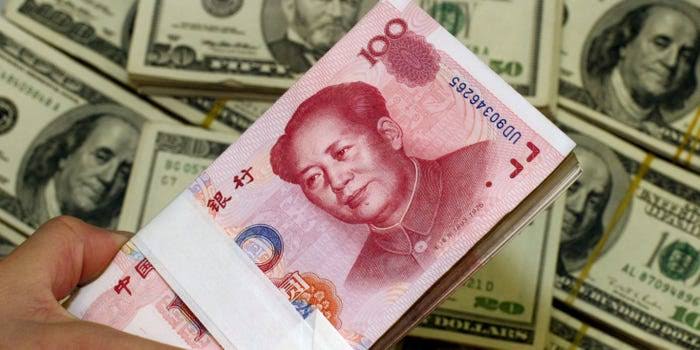Alwaght- China is taking some measures to further globalize use of its national currency, yuan. This campaign by Beijing comes as the world trust in the US dollar is dwindling.
Many economic reports, include one by CBS News, confirm the fall of the global trust in the US dollar. Experts say that the Chinese moves to strengthen its currency is meant to challenge dollar. Though the latter remains the leading currency for world trade, Chinese policies have managed to challenge this leadership.
Economic reports reveal the US dollar has slumped more than 9 percent this year, while the global use of China's yuan has climbed over 2 percent. A CNBC report from the first half of 2025 confirms the dollar has plunged against the euro, pound, and Chinese yuan, with many global investors calling this the dollar's worst performance in the modern era.
Trump's measures backfire
The US President Donald Trump has long shown a fierce determination to defend the global dominance of the dollar, even threatening BRICS countries with economic punishment and steep tariffs if they de-dollarized. Yet, according to recent reports, it is Trump’s own policies that have become one of the main drivers behind the dollar’s declining international standing.
Trump’s trade strategies during his second term, particularly the imposition of heavy tariffs on foreign nations, have undermined confidence in both the US’s fiscal discipline and the independence of the Federal Reserve. As a result, global trust in the dollar’s stability has waned. Many observers now note that Trump’s executive orders can swing the dollar’s value sharply and unpredictably, a volatility that has pushed traders and governments alike to seek out more stable alternative currencies.
Amid this growing skepticism toward the dollar, China’s financial institutions have intensified efforts to internationalize the yuan. A senior executive at the Bank of China’s Hong Kong branch told Global Neighbors: “Financial institutions and banks that once ignored the yuan now readily trade and accept it as a legitimate foreign currency.”
Even the European Central Bank (ECB) has taken note of the dollar’s slipping influence. In her July 2025 financial report, ECB President Christine Lagarde acknowledged the dollar’s shrinking share in global transactions and called for measures to strengthen the euro’s international role.
The logic of dollar dominance
According to the statement by the People's Bank of China (PBOC), yuan is now the second biggest trade currency and the third biggest currency for direct trade settlements in the world. However, the internationalization of the yuan remains a bumpy road. According to Yu Yongding, an expert at the Chinese Academy of Social Sciences, the comprehensive internationalization and globalization of a foreign currency, including the yuan, is a "long-term and complex process."
Data from both the PBOC and the US Treasury reports indicate that although the yuan's internationalization has expanded significantly over the past decade, it still lags behind the dollar and the euro. While China is the world's second-largest economy and holds a dominant international trade position, control over capital flows, predictability, and the world's major financial markets remains largely in the hands of the US dollar.
In general, the more a currency is used and traded globally, the easier and more efficient its trade and settlement become. The dollar still possesses these two critical features, and they form the very logic behind the US dollar's continued dominance.
China's tools to boost yuan
To boost their national currency use in the world, the Chinese over the past years established a cross-border payment system called Cross-border Interbank Payment System (CIPS).
China is pushing to unseat West's SWIFT with their CIPS. SWIFT was launched in May 1973 by 239 banks from fifteen countries to create a standardized global system for financial transactions, replacing non-standard and paper-based methods. However, in recent years, it has been leveraged by Western nations as a tool against other countries.
In response, China quietly launched its own alternative, CIPS, in 2015. The system has since evolved into a veritable highway for international and foreign payments. As of August 2025, the CIPS network has connected over 1,700 financial institutions across 180 countries, including major entities in Africa, West Asia, Central Asia, and Southeast Asia.
The figures for CIPS tell a powerful story. In 2024 alone, a staggering CNY 175 trillion (USD 24.5 trillion) was settled through the system, a striking 43 percent annual increase. This makes CIPS a critical tool, simultaneously facilitating the easier global use of the yuan while breaking the monolithic dominance of SWIFT. According to a report by Global Neighbors, by the end of 2024, over 1,000 foreign financial institutions had opened yuan-denominated accounts with banks connected to CIPS, a clear statistic demonstrating the currency's growing use through a channel entirely outside the SWIFT system.
Yuan's tough path against dollar
Though world use of yuan has expanded, there are still many challenges for total globalization of this currency. According to a statement by Chinese State Administration of Foreign Exchange, yuan accounted for roughly 54 percent of China's foreign payments by June this year, double the percentage of a decade ago.
The Chinese yuan overtook the euro in 2023 to become the world's second-largest currency for trade finance. A 2025 analytical report from China's central bank reveals that 77 percent of businesses in ASEAN nations now prefer using the yuan for trade with China. Surveys indicate a clear shift in corporate strategy, driven by declining liquidity for the dollar and euro. Nearly 80 percent of international companies report they are now considering the yuan as a viable alternative to those traditional currencies.
Quietly fueling this transition, Chinese banks are rapidly expanding yuan-denominated lending abroad. By June 2025, Chinese financial institutions had extended CNY 1.15 trillion in loans to foreign companies, the highest level seen in decades.
Still, for yuan to rise as a true global currency, it needs more than political support. Experts describe the existence of a rebust offshore market to take on dollar and euro as a necessity. Meanwhile, the Chinese seem to have their eyes on Hong Kong as the international stronghold of yuan. The financial relations of Hong Kong with almost all of countries and international organizations make this region of China a bridge linking Beijing to ASEAN states, Central Asia and even the West, and the Chinese have the certainty that Hong Kong as the global center of yuan transactions will unseat New York as the world center of dollar transactions.



























